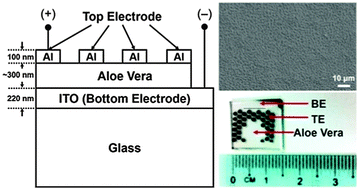Effects of drying temperature and ethanol concentration on bipolar switching characteristics of natural Aloe vera-based memory devices
Abstract
Extracted, formulated, and processed natural Aloe vera has been used as an active layer for memory applications. The functional memory device is realized by a bottom-up structure of ITO/Aloe vera/Al in which the Aloe vera is spin-coated after mixing with different concentrations of ethanol (0–80 wt%) and subsequently dried at different temperatures (50–120 °C). From the current density–voltage measurements, the device can exhibit a reproducible bipolar switching characteristic with pure Aloe vera dried at 50 °C. It is proposed that charges are transported across the Aloe vera layer via space-charge-limited conduction (SCLC), and clusters of interstitial space formed by the functional groups of acemannans and de-esterified pectins in the dried Aloe vera contribute to the memory effect. The formation of charge traps in the Aloe vera layer is dependent on the drying temperature. The drying temperature of a memory-switching Aloe vera layer can be extended to 120 °C with the addition of appropriate amounts of ethanol. The concept of using natural Aloe vera as an active material for memory applications has been demonstrated, and the read memory window, ON/OFF ratio, and retention time are approximately 5.0 V, 103, and >104 s, respectively.


 Please wait while we load your content...
Please wait while we load your content...